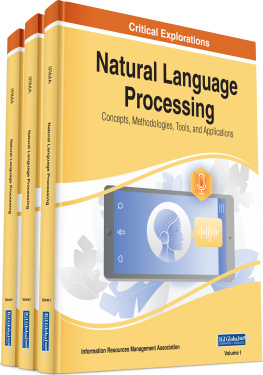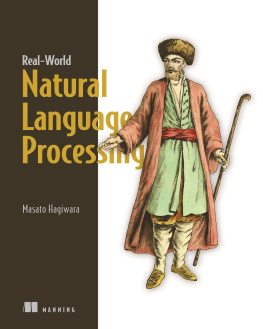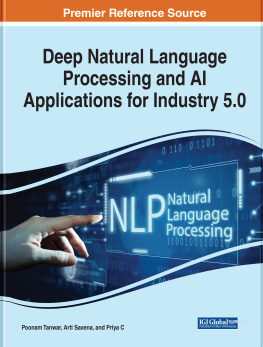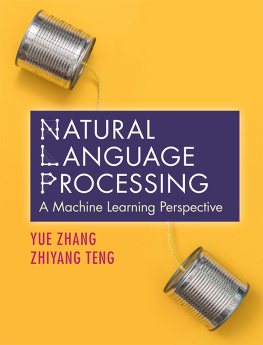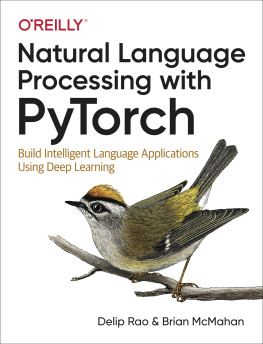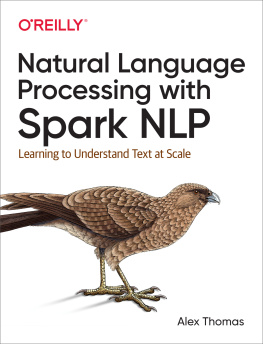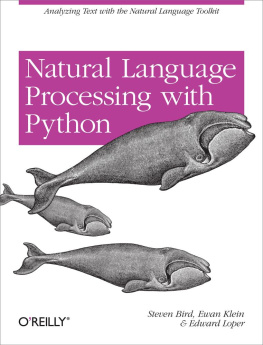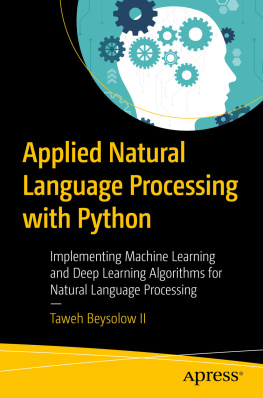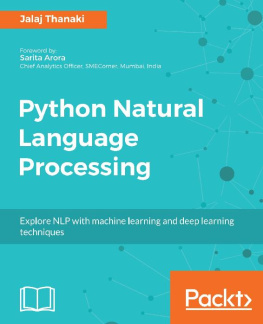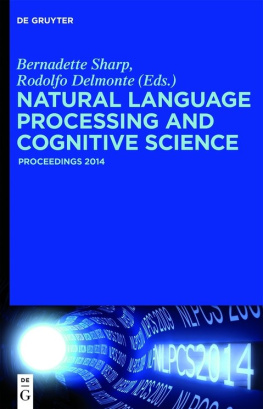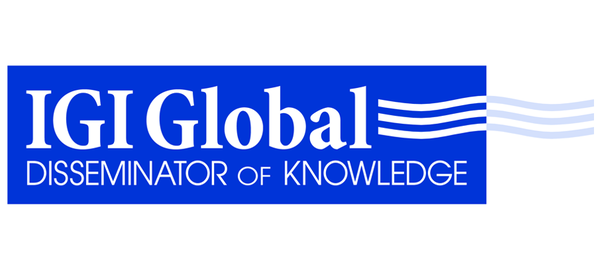Natural Language Processing:
Concepts, Methodologies, Tools, and Applications
- Information Resources Management Association
USA
Published in the United States of America by IGI Global (an imprint of IGI Global) 701 E. Chocolate Avenue Hershey PA 17033 Tel: 717-533-8845 Fax: 717-533-8661 E-mail: cust@igi-global.com Web site: http://www.igi-global.com/reference
Copyright 2020 by IGI Global. All rights reserved. No part of this publication may be reproduced, stored or distributed in any form or by any means, electronic or mechanical, including photocopying, without written permission from the publisher.
Product or company names used in this set are for identification purposes only. Inclusion of the names of the products or companies does not indicate a claim of ownership by IGI Global of the trademark or registered trademark.
Library of Congress Cataloging-in-Publication Data
Names: Information Resources Management Association, editor.
Title: Natural language processing : concepts, methodologies, tools, and
applications / Information Resources Management Association.
Other titles: Natural language processing (Engineering Science Reference
(Publisher))
Description: Hershey : Engineering Science Reference, 2019. | Includes
bibliographical references and index. | Summary: "This book examines the
latest concepts, processes, and techniques for communication between
computers and humans"-- Provided by publisher.
Identifiers: LCCN 2019023675 (print) | LCCN 2019023676 (ebook) | ISBN
9781799809517 (hardcover) | ISBN 9781799809524 (ebook)
Subjects: LCSH: Natural language processing (Computer science) |
Computational linguistics. | Human-computer interaction--Industrial
applications.
Classification: LCC QA76.9.N38 N3835 2019 (print) | LCC QA76.9.N38
(ebook) | DDC 006.3/5--dc23
LC record available at https://lccn.loc.gov/2019023675
LC ebook record available at https://lccn.loc.gov/2019023676
British Cataloguing in Publication Data
A Cataloguing in Publication record for this book is available from the British Library.
All work contributed to this book is new, previously-unpublished material. The views expressed in this book are those of the authors, but not necessarily of the publisher.
Editor-in-Chief
Mehdi Khosrow-Pour, DBA
Information Resources Management Association, USA
Associate Editors
Steve Clarke, University of Hull, UK
Murray E. Jennex, San Diego State University, USA
Ari-Veikko Anttiroiko, University of Tampere, Finland
Editorial Advisory Board
Sherif Kamel, American University in Cairo, Egypt
In Lee, Western Illinois University, USA
Jerzy Kisielnicki, Warsaw University, Poland
Amar Gupta, Arizona University, USA
Craig van Slyke, University of Central Florida, USA
John Wang, Montclair State University, USA
Vishanth Weerakkody, Brunel University, UK
Preface
Information in todays advancing world is rapidly expanding and becoming widely available. This eruption of data has made handling it a daunting and time-consuming task. Natural language processing (NLP) is a method that applies linguistics and algorithms to large amounts of this data to make it more valuable. Persistent research in the field of natural language processing enables an understanding of the world around us in addition to opportunities for manmade computing to mirror natural language processes that have existed for centuries.
Staying informed of the most up-to-date research trends and findings is of the utmost importance. That is why IGI Global is pleased to offer this three-volume reference collection that will shed light on critical issues on the methods and applications of linguistic information processing and its computational properties by providing both broad and detailed perspectives on cutting-edge theories and developments. This reference is designed to act as a single reference source on conceptual, methodological, technical, and managerial issues, as well as provide insight into emerging trends and future opportunities on the fundamental concepts and techniques of natural language processing.
Natural Language Processing: Concepts, Methodologies, Tools, and Applications is organized into seven distinct sections that provide comprehensive coverage of important topics. The sections are:
- 1. Fundamental Concepts and Theories;
- 2. Development and Design Methodologies;
- 3. Tools and Technologies;
- 4. Utilization and Applications;
- 5. Organizational and Social Implications;
- 6. Critical Issues and Challenges; and
- 7. Emerging Trends.
The following paragraphs provide a summary of what to expect from this invaluable reference tool.
Section 1, Fundamental Concepts and Theories, serves as a foundation for this extensive reference tool by addressing crucial theories essential to the understanding of natural language processing. Introducing the book is Background Review for Neural Trust and Multi-Agent System, by Prof. Gehao Lu of the University of Huddersfield, UK & Yunnan University, China and Prof. Joan Lu from the University of Huddersfield, UK: a great foundation laying the groundwork for the basic concepts and theories that will be discussed throughout the rest of the book. Section 1 concludes and leads into the following portion of the book with a nice segue chapter, Aspect-Based Sentiment Analysis of Online Product Reviews, by Profs. Vinod Kumar Mishra and Himanshu Tiruwa from Bipin Tripathi Kumaon Institute of Technology, India.
Section 2, Development and Design Methodologies, presents in-depth coverage of the conceptual design and architecture of natural language processing. Opening the section is Compliance With International Soft Law: Is the Adoption of Soft Law Predictable? by Prof. Michael D'Rosario from Deakin Business School, Deakin University, Sydney, Australia and Prof. John Zeleznikow from the College of Business, Victoria University, Melbourne, Australia. Through case studies, this section lays excellent groundwork for later sections that examine present and future applications for natural language processing. The section concludes with an excellent work by Prof. Armando Vieira of Redoctopus, UK, Business Applications of Deep Learning.
Section 3, Tools and Technologies, presents extensive coverage of the various tools and technologies used in the implementation of natural language processing. The first chapter, Agreement Technologies for Conflict Resolution, by Prof. Vicente Julian from the Universidad Politcnica de Valencia, Spain; Prof. Victor Sanchez-Anguix from Coventry University, UK; and Profs. Stella Heras and Carlos Carrascosa from the Universidad Politcnica de Valencia, Spain, lays a framework for the types of works that can be found in this section. The section concludes with A Fuzzy Logic Based Synonym Resolution Approach for Automated Information Retrieval, by Profs. Mamta Kathuria, Chander Kumar Nagpal, and Neelam Duhan of the YMCA University of Science and Technology, Faridabad, India. Where Section 3 described specific tools and technologies at the disposal of practitioners, Section 4 describes the use and applications of the tools and frameworks discussed in previous sections.
Section 4, Utilization and Applications, describes how the broad range of natural language processing efforts has been utilized and offers insight on and important lessons for their applications and impact. The first chapter in the section is Finding the Semantic Relationship Between Wikipedia Articles Based on a Useful Entry Relationship, written by Prof. Lin-Chih Chen from the Department of Information Management, National Dong Hwa University, Hualien, Taiwan. This section includes the widest range of topics because it describes case studies, research, methodologies, frameworks, architectures, theory, analysis, and guides for implementation. The breadth of topics covered in this section is also reflected in the diversity of its authors, from countries all over the globe. The section concludes with A Study of the State of the Art in Synthetic Emotional Intelligence in Affective Computing, by Prof. Syeda Erfana Zohora from Taif University, Taif, Saudi Arabia; Prof. A. M. Khan from Mangalore University, Magalore, India; Prof. Arvind K. Srivastava of Systron Donner Inertial, Concord, CA, USA; Prof. Nhu Gia Nguyen from Duy Tan University, Da Nang, Vietnam; and Prof. Nilanjan Dey of TechnoIndia College of Technology, Kolkata, India, a great transition chapter into the next section.

